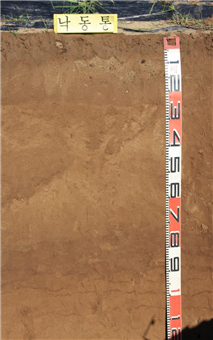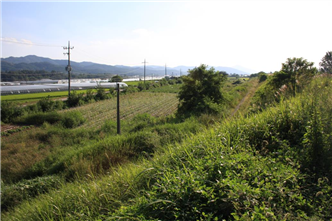

Morphological properties of typifying pedon.
|
|
NAGDONG SERIES |
Established Series UKT, KBJ, JFD 21 November, 1969 |
The Nagdong series are members of the mixed, mesic family of Typic Quartzipsamments [Haplic Arenosols (Eutric) classified by WRB]. These soils have dark yellowish brown loamy fine sand Ap horizons, dark yellowish brown fine sand C1 horizons, dark yellowish brown loamy fine sand C2 horizons, and yellowish brown fine sand C3 horizons. They occur on continental river levees.
Typifying pedon: Nagdong loamy fine sand-vegetables (Colors are for moist soil).
Slope: 0-2%
Elevation: 72 m above m.s.l.
Soil moisture regime: Udic
Soil temperature regime: Mesic
Parent material: Alluvium
Diagnostic features: An ochric epipedon from a depth of 0 to 23 cm.
Described by: Song, K. C., D. C. Noh, and B. K. Hyun, 6 Sep., 2011.
|
|
|
|
|
Morphological properties of typifying pedon. |
||
Ap - 0 to 23 cm. Dark yellowish brown (10YR 4/4) loamy fine sand; weak fine to medium subangular blocky structure; friable, non sticky and non plastic; common fine to medium roots; few medium pores; few worm holes; common very fine micas; clear smooth boundary.
C1 - 23 to 70 cm. Dark yellowish brown (10YR 4/4) fine sand; structureless, single grained; loose, non sticky and non plastic; few very fine to fine roots; no pores; common very fine micas; clear smooth boundary.
C2 - 70 to 95 cm. Dark yellowish brown (10R 3/6) loamy fine sand; weak medium platy structure; friable, slightly sticky and slightly plastic; no roots; common fine to medium pores; common very fine micas; clear wavy boundary.
C3 - 95 to 180 cm. Yellowish brown (10YR 5/4) fine sand; structureless, single grained; loose, non sticky and non plastic; no pores; common very fine micas.
The typifying pedon has an ochric epipedon from a depth of 0 to 23 cm. But it does not have other diagnostic horizons. Therefore it can be classified as Entisol. It has less than 35% rock fragments and a texture class of loamy fine sand or coarser in all layers within the particle-size control section. It keys out as Psamment. It has, in the 0.02 to 2.0 mm fraction within the particle-size control section, a total of more than 90% resistant minerals. It can be classified as Quartzipsamment. Also it meets the requirements of Typic Quartzipsamment. The typifying pedon has mesic soil temperature regime, and can be classified as mixed, mesic family of Typic Quatzipsamment.
Type Location: About 30 meters west of Gwangdeog 1 Ri, Pungcheon Myeon, Andong city, Gyeongsangbug Do (128° 30' 16.5'', 36° 32' 48.6'').
Range in Characteristics: These soils have ochric epipedons. Soil depth is in excess of 150 cm and probably ranges to 3 meters or more over any very contrasting materials. The series contains common to many fine mica flakes. Reaction is slightly acid to neutral. Base saturation is more than 60 percent. A horizons are brown or yellowish brown loamy fine sand, loamy sand, or fine sandy loam. C horizons are brown or yellowish brown loamy fine sand to fine sand.
Competing Series and Their Differentiae: These are the Hwabong, Bonryang, Jangcheon, and Jungdong series. The Hwabong soils belong to the same texture family but have coarser particle sizes and less moisture holding capacity. The Bonryang series are characterized by having moderately deep coarse loamy over sandy texture. The Jangcheon soils have gray colored surface horizons and are used for rice paddy. The Jungdong series has very fine sandy loam or fine sandy loam textures throughout.
Setting: The Nagdong soils occur on nearly level to very gently sloping undissected continental broad alluvial flood plain levees chiefly adjacent to river channels and on the convex side of river bends. Slopes range from 0 to 2 percent.
Principal Associated Soils: These are the Hwabong, Bonryang, Ihyeon and Gyuam soils. The Ihyeon soils have finer textures and greater moisture holding capacity. The Gyuam soils are moderately well drained and have finer textures.
Drainage and Permeability: Somewhat excessively drained. Permeability is rapid to very rapid. Runoff is slow.
Use and Vegetation: Most areas are used for crops such as peanuts, rye and melon.
Distribution and Extent: The Nagdong soils are of moderate extent and occur on the large flood plains throughout the country.
Series Established: Buyeo Gun, Chungcheongnam Do, 1969. Revised, Andong city, Gyeongsangbug Do, 2011.
Laboratory data sheets of typifying.
|
Depth (cm) |
Horizon |
( --- Total ---) |
(-- Clay --) |
(-- Silt --) |
(------- Sand -------) |
||||||||
|
Clay |
Silt |
Sand |
Fine |
Coarse |
Fine |
Coarse |
VF |
F |
M |
C |
VC |
||
|
LT |
.002 |
.05 |
LT |
LT |
.002 |
.02 |
.05 |
.10 |
.25 |
.5 |
1 |
||
|
.002 |
- .05 |
- 2 |
.0002 |
.002 |
- .02 |
- .05 |
- .10 |
- .25 |
- .50 |
- 1 |
- 2 |
||
|
- - - - - - - - - - - Pct of ˂ 2mm (3A1) - - - - - - - - - - - |
|||||||||||||
|
0-23 |
Ap |
5.6 |
15.0 |
79.4 |
|
|
6.4 |
8.6 |
5.7 |
23.3 |
33.6 |
16.2 |
0.6 |
|
23-70 |
C1 |
2.8 |
7.9 |
89.3 |
|
|
3.2 |
4.7 |
7.1 |
39.0 |
32.3 |
10.6 |
0.4 |
|
70-95 |
C2 |
7.5 |
15.2 |
77.4 |
|
|
9.1 |
6.1 |
18.0 |
34.3 |
23.4 |
1.6 |
0.1 |
|
95-180 |
C3 |
2.5 |
4.3 |
93.2 |
|
|
1.9 |
2.4 |
4.6 |
53.4 |
32.7 |
2.4 |
0 |
|
Depth (cm) |
Coarse Fractions(mm) |
˃2mm |
Orgn |
Total |
Extr |
Total |
(-- Dith -Cit --) |
|||||
|
Weight |
Wt |
C |
N |
P |
S |
Extractable |
||||||
|
2-5 |
5-20 |
20-75 |
.1-75 |
Pct of |
|
|
|
|
Fe |
Al |
Mn |
|
|
|
|
|
|
Whole |
6A1c |
6B3a |
6S3 |
6R3a |
6C2b |
6G7a |
6D2a |
|
|
Pct of ˂ 75mm (3B1) |
Soil |
Pct ˂ 2mm |
g/kg |
Pct of ˂ 2mm |
||||||||
|
0-23 |
|
|
|
|
|
0.10 |
|
|
|
|
|
|
|
23-70 |
|
|
|
|
|
0 |
|
|
|
|
|
|
|
70-95 |
|
|
|
|
|
0.04 |
|
|
|
|
|
|
|
95-180 |
|
|
|
|
|
0 |
|
|
|
|
|
|
|
Depth (cm) |
Ratio/Clay |
Atterberg |
( Bulk Density ) |
COLE |
(- Water Content -) |
WRD |
|||||||
|
CEC |
1500 |
Limits |
Field |
33 |
Oven |
Whole |
Field |
10 |
33 |
1500 |
Whole |
||
|
|
kPa |
LL |
PI |
Moist |
kPa |
Dry |
Soil |
Moist |
kPa |
kPa |
kPa |
Soil |
|
|
8D1 |
8D1 |
4P1 |
4P |
4A3a |
4A1d |
4A1h |
4D1 |
4B4 |
4B1c |
4B1c |
4B2a |
4C1 |
|
|
|
|
Pct ˂0.4mm |
- - g/cc - - |
cm/cm |
-- Pct of ˂2mm -- |
cm/cm |
|||||||
|
0-23 |
1.07 |
|
|
|
1.29 |
|
|
|
4.7 |
|
|
|
|
|
23-70 |
1.24 |
|
|
|
1.38 |
|
|
|
8.1 |
|
|
|
|
|
70-95 |
0.85 |
|
|
|
1.58 |
|
|
|
19.8 |
|
|
|
|
|
95-180 |
1.14 |
|
|
|
1.31 |
|
|
|
12.0 |
|
|
|
|
|
Depth (cm) |
( NH4OAc Extractable Bases ) |
Acid- |
Extr |
(----- CEC -----) |
Al |
||||||
|
Ca |
Mg |
K |
Na |
Sum |
ity |
Al |
Sum |
NH4- |
Bases |
Sat |
|
|
5B5a |
5B5a |
5B5a |
5B5a |
Bases |
|
|
Cats |
OAc |
+ Al |
|
|
|
6N2e |
6O2d |
6Q2b |
6P2b |
|
6H5a |
6G9a |
5A3a |
5A8b |
5A3b |
5G1 |
|
|
- - - - - - - - - - - - meq / 100g - - - - - - - - - - - - |
Pct |
||||||||||
|
0-23 |
3.5 |
1.7 |
0.2 |
0 |
5.4 |
3.1 |
0 |
8.6 |
6.0 |
5.4 |
0 |
|
23-70 |
1.9 |
0.7 |
0.2 |
0 |
2.9 |
4.0 |
0 |
6.9 |
3.5 |
2.9 |
0 |
|
70-95 |
3.3 |
1.4 |
0.2 |
0 |
4.9 |
6.3 |
0.2 |
11.2 |
6.4 |
5.1 |
3.9 |
|
95-180 |
1.4 |
0.6 |
0.1 |
0 |
2.1 |
4.4 |
0.1 |
6.5 |
2.9 |
2.2 |
4.5 |
|
Depth (cm) |
(Base Sat) |
CO3 as |
Res |
Cond |
(------ pH ------) |
Acid Oxalate Extraction |
|||||||
|
Sum |
NH4- |
CaCO3 |
|
|
NaF |
KCl |
CaCl2 |
H2O |
Opt |
Al |
Fe |
Si |
|
|
|
OAc |
˂2mm |
|
|
|
|
.01M |
|
Den |
|
|
|
|
|
5C3 |
5C1 |
6E1g |
8E1 |
8I |
8C1d |
|
8C1f |
8C1f |
8J |
6G12 |
6C9a |
6V2 |
|
|
---- Pct ---- |
ohms/cm |
dS/m |
|
1: 1 |
1: 2 |
1: 1 |
|
- Pct of ˂2mm - |
|||||
|
0-23 |
63.4 |
90.9 |
|
|
|
|
6.6 |
6.9 |
7.5 |
|
|
|
|
|
23-70 |
42.2 |
83.6 |
|
|
|
|
5.2 |
6.1 |
7.1 |
|
|
|
|
|
70-95 |
44.0 |
76.9 |
|
|
|
|
4.3 |
5.4 |
6.4 |
|
|
|
|
|
95-180 |
32.7 |
73.8 |
|
|
|
|
4.4 |
5.5 |
6.4 |
|
|
|
|